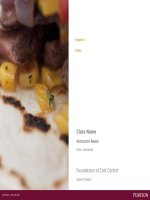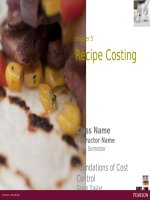Foundations of cost control by daniel traster chapter05
Bạn đang xem bản rút gọn của tài liệu. Xem và tải ngay bản đầy đủ của tài liệu tại đây (945.03 KB, 39 trang )
chapter 5
Recipe Costing
Class Name
Instructor Name
Date, Semester
Foundations of Cost
Control
Daniel Traster
The Costing Sheet
The goal of the costing sheet is to determine
the total recipe cost and cost per portion.
To complete, it requires:
• A recipe with a list of ingredients and their
quantities
• Y% for each ingredient as it is to be
prepped
• AP$ for each ingredient
• EP$ for any item requiring a butcher’s test
2
Costing Sheet: Heading
The costing sheet heading includes the
following:
• Recipe Name
• Number of Portions (Yield) for the recipe
• Cost per Portion (calculated in the costing
sheet)
• Spice Factor and Q Factor
• FC% and Selling Price (covered in next
chapter)
3
Sample Costing Sheet before
Calculations
Recipe: Cous Cous with Carrots and Raisins
Spice Factor:
Portions: 8
Factor:
Cost per portion:
FC%
Price:
Ingredien
t
Quanti
ty
Y%
AP$
Cous Cous
2 cups
100%
$4.20/Qt
Carrot,
diced
4 oz
77%
$0.68/#
Raisins
4 oz
100%
$4.37/#
Chicken
Stock
16 oz
100%
$0.84/Qt
Parsley,
chopped
2 Tbsp
1 bun =
8 Tbsp
$0.72/bu
n
To taste
Spice
Factor
Salt/Pepper To taste
AP$
converte
d
EP$
Q
Selling
Extended
$
4
Converting Units in Costing Sheet
Units in “price per unit” must match the
units in the ingredient list.
Invoice units and ingredient units don’t
often match.
5
Common Invoice Pricing
Invoices often list prices per case size, which
may be broken down as number of units in a
case and size per unit.
• Examples:
―12/1Qt
―40#
―8/5#
―6/#10 cans
―80 count
Written as “number/number with unit” the first
number is the number of containers in a case.
The second is the size of each container.
6
Making Invoice Pricing Useable
1) Calculate total weight or volume as:
Total wt. = number of units X weight per
unit
2) For volume, substitute volume for weight.
3) Next, calculate AP$ (per unit) as:
AP$ = total cost ÷ total weight (or vol.)
7
Example 5a
Diced tomato costs $16.54 for a case of
6/#10 cans. Kitchen tests show a #10 can
contains 6# 6oz of product. What is the
cost per oz?
6# 6oz = 102 oz
Total wt. = units X wt/unit =
6 X 102oz = 612oz
Cost/unit = cost ÷ total wt. =
$16.54 ÷ 612oz
= $0.027/oz
8
Example 5b
Vinegar costs $31.80 for 4/1Gal. What is
the cost per cup?
1 Gal = 16 cups
Total vol. = 4 units X 16 c/unit = 64 cups
Cost/unit = cost ($31.80) ÷ vol. (64c)
=$0.497/c
9
Possible Complications in Unit Conversion
1. Weight listed on can is not the same as
product’s drained weight.
•
Solution: test a can and use the drained weight for
the calculation.
2. Container measures contents in weight but
recipe measures in volume or vice-versa.
•
Solution: Open container to measure volume (or
weight) and use this figure for calculations.
Note: In both cases, Y% is accounted for by
test, so Y% becomes 100% on costing sheet.
See Figure 5.1b
10
Calculating EP$ for Costing Sheet
EP$ = AP$ ÷ Y%
• Y% in decimal form.
• Only use AP$ with units that match the
ingredient’s units.
• For items from a butcher’s yield test, just
enter the EP$ from the test and convert to
units that match the ingredient’s units.
• For items with Y% = 100%, AP$ = EP$
See Figure 5.1c
11
Calculating Extended Costs or “Extension”
Extended cost or extension is the total
amount of money that each ingredient
contributes to the total cost of the recipe.
Extension = Ingredient Quantity x
EP$/unit
See Figure 5.1d
12
Total Recipe Cost
13
Cous Cous Recipe: Part II
Recipe: Cous Cous with Carrots and Raisins
Spice Factor:
Portions: 8
Factor:
Cost per portion:
FC%
Price:
Q
Selling
Ingredient
Quantit
y
Y%
AP$
AP$
converte
d
EP$
Extended
Cost
Cous Cous
2 cups
100%
$4.20/Qt
$1.05/c
$1.05/c
$2.10
Carrot,
diced
4 oz
77%
$0.68/#
$0.043/oz
$0.056/o
z
$0.224
Raisins
4 oz
100%
$4.37/#
$0.273/oz
$0.273/o
z
$1.092
Chicken
Stock
16 oz
100%
$0.84/Qt
$0.026/oz
$0.026/o
z
$0.416
Parsley,
chopped
2 Tbsp
1 bun =
8 Tbsp
$0.72/bun
$0.09/Tbs
$0.09/Tb
s
$0.18
Salt/Pepper
To taste
To taste
Spice
Factor
S.F
S.F.
N/A
TOTAL
$4.01
14
2
Spice Factor (S.F.)
• Adjusts recipe cost for ingredients like spices,
herbs, and seasonings.
• Each operation decides what ingredients are
included in Spice Factor.
• Saves time on costing each spice or herb
separately in a recipe.
• Allows for seasoning “to taste.”
15
Spice Factor S.F.)
• Divides cost of spices and seasoning across
all dishes rather than making heavily spices
ones extremely expensive.
• Can be used to account for garnishes and
“reject” dishes returned by customer
• Can be applied either to recipe’s total cost or
to cost per portion
16
Determining the Spice Factor
1. Decide which items will be included in spice
factor. Calculate cost spent on those items
over a period of time.
2. If desired, include value of “reject” or ruined
dishes over the same period.
S.F. = value of S.F. items ÷ value of total food
purchases
(over the same period)
3. Convert S.F. to % form.
17
Example 5c
Restaurant purchases $120,000 in food
over 3 months. Spice factor items over
that period are valued at $2,600. What is
the restaurant’s spice factor?
SF = Value of SF items ÷ total food purchases
= $2,600 ÷ $120,000 =
0.0216 or 2.2%
18
Adjusting Recipe’s Cost Using S.F.
SF-adjusted recipe cost =
Recipe Cost x (1+S.F. in decimal form)
• Use this equation on all recipes regardless of
spice or herb use
• If dish contains multiple components, adjust
each recipe for SF.
19
Example 5d
A recipe’s total cost is $27.72. SF = 2.2%.
What is the SF-adjusted cost for the recipe?
SF-adjusted cost = recipe cost X (1+SF)
= $27.72 X (1 + 0.022) =
$27.72 X 1.022
= $28.33
20
Q Factor
• Applies only to entrées
• Accounts for add-ons, side dishes, or other
“freebies” that come with an entrée
• Added (not multiplied) to the entrée price
21
Process to determine Q Factor
1. Complete costing sheet for all possible addons (soup, salad, bread, butter, dessert,
etc.), if any, that come with the purchase of
an entrée.
2. Select the most expensive cost per portion
among each set of choices the customer
gets.
22
Why Q Factor?
• If guest orders the most expensive add-ons
with his/her dish, the cost is covered in the
entrée’s cost (and thus, sales price).
• If guest chooses cheaper add-ons, the
restaurant realizes extra profit.
23
Example 5e
Restaurant includes choice of soup or salad
and bread and butter with each entrée.
What is restaurant’s Q Factor if:
Chicken Noodle Soup = $0.58
Cream of Broccoli Soup = $0.53
House Salad = $0.85
Spinach Salad = $0.97
Bread = $0.12
Butter = $0.08
24
Example 5e (cont.)
• Most expensive choice for soup or salad is
Spinach Salad at $0.97.
• Bread is $0.12 and butter is $0.08
Q Factor = total of most expensive
choices
= $0.97 + $0.12 + $0.08
= $1.17
25









